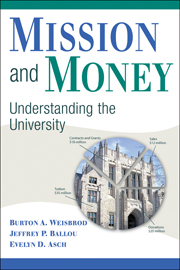Book contents
- Frontmatter
- Contents
- Illustrations
- Preface
- 1 An Introduction to the Higher Education Industry
- 2 The Higher Education Business and the Business of Higher Education – Now and Then
- 3 Is Higher Education Becoming Increasingly Competitive?
- 4 The Two-Good Framework: Revenue, Mission, and Why Colleges Do What They Do
- 5 Tuition, Price Discrimination, and Financial Aid
- 6 The Place of Donations in Funding the Higher Education Industry
- 7 Endowments and Their Management: Financing the Mission
- 8 Generating Revenue from Research and Patents
- 9 Other Ways to Generate Revenue – Wherever It May Be Found: Lobbying, the World Market, and Distance Education
- 10 Advertising, Branding, and Reputation
- 11 Are Public and Nonprofit Schools “Businesslike”? Cost-Consciousness and the Choice between Higher Cost and Lower Cost Faculty
- 12 Not Quite an Ivory Tower: Schools Compete by Collaborating
- 13 Intercollegiate Athletics: Money or Mission?
- 14 Mission or Money: What Do Colleges and Universities Want from Their Athletic Coaches and Presidents?
- 15 Concluding Remarks: What Are the Public Policy Issues?
- Appendix
- References
- Index
8 - Generating Revenue from Research and Patents
Published online by Cambridge University Press: 17 July 2009
- Frontmatter
- Contents
- Illustrations
- Preface
- 1 An Introduction to the Higher Education Industry
- 2 The Higher Education Business and the Business of Higher Education – Now and Then
- 3 Is Higher Education Becoming Increasingly Competitive?
- 4 The Two-Good Framework: Revenue, Mission, and Why Colleges Do What They Do
- 5 Tuition, Price Discrimination, and Financial Aid
- 6 The Place of Donations in Funding the Higher Education Industry
- 7 Endowments and Their Management: Financing the Mission
- 8 Generating Revenue from Research and Patents
- 9 Other Ways to Generate Revenue – Wherever It May Be Found: Lobbying, the World Market, and Distance Education
- 10 Advertising, Branding, and Reputation
- 11 Are Public and Nonprofit Schools “Businesslike”? Cost-Consciousness and the Choice between Higher Cost and Lower Cost Faculty
- 12 Not Quite an Ivory Tower: Schools Compete by Collaborating
- 13 Intercollegiate Athletics: Money or Mission?
- 14 Mission or Money: What Do Colleges and Universities Want from Their Athletic Coaches and Presidents?
- 15 Concluding Remarks: What Are the Public Policy Issues?
- Appendix
- References
- Index
Summary
Research has become big business and a growing source of revenue, especially in recent decades. Yet it remains true that research and its follow-on activities, patenting and licensing, are the domain of a small fraction of the higher education industry. For-profit schools do not engage in research and, indeed, are not even eligible for federal grants from National Institutes of Health (NIH) or the National Science Foundation (NSF). Community colleges do not engage in significant amounts of scientific research of the sort that generates grants from government or corporations, nor do liberal arts colleges, including the most prestigious. Even many schools classified as research universities receive, for the most part, relatively inconsequential amounts of research grants. Only the elite public and private universities are involved in “big” research.
RESEARCH AND RESEARCH UNIVERSITIES
Research has been a substantial growth sector, as we can see from Figure 8.1. Following a period of quiescence from the late 1960s through the 1970s, the rate of growth of university spending on research and development (R&D) quickened in the 1980s (and not by accident, as we shall see below), increasing again in the second half of the 1980s. Over the entire period beginning in 1953, research spending grew from $817 million to an estimated $42.8 billion in 2006, more than a 50-fold increase in constant dollars. As a share of total higher education expenditures, R&D expenditures have increased substantially, from 9 percent in 1971 to 15 percent in 2006.
- Type
- Chapter
- Information
- Mission and MoneyUnderstanding the University, pp. 149 - 161Publisher: Cambridge University PressPrint publication year: 2008

